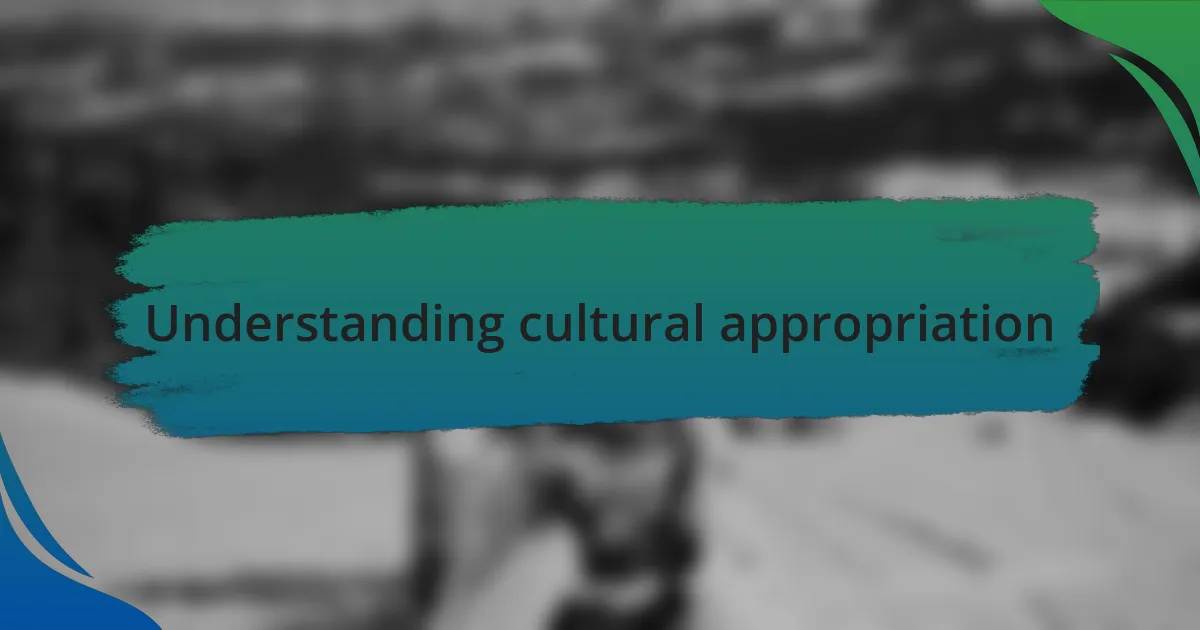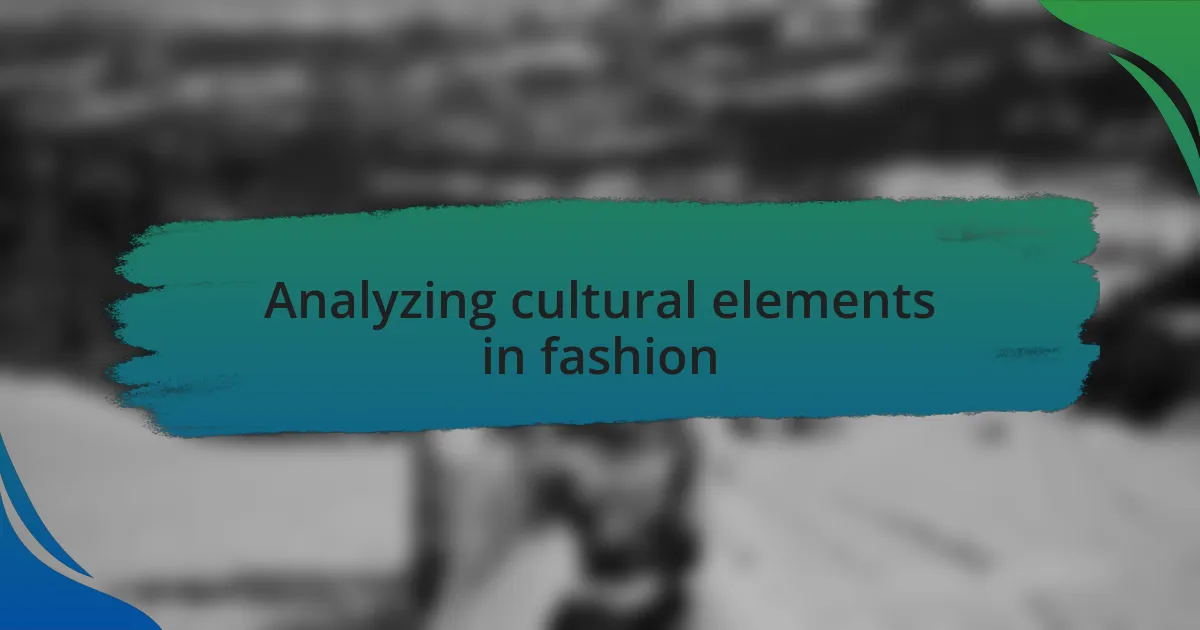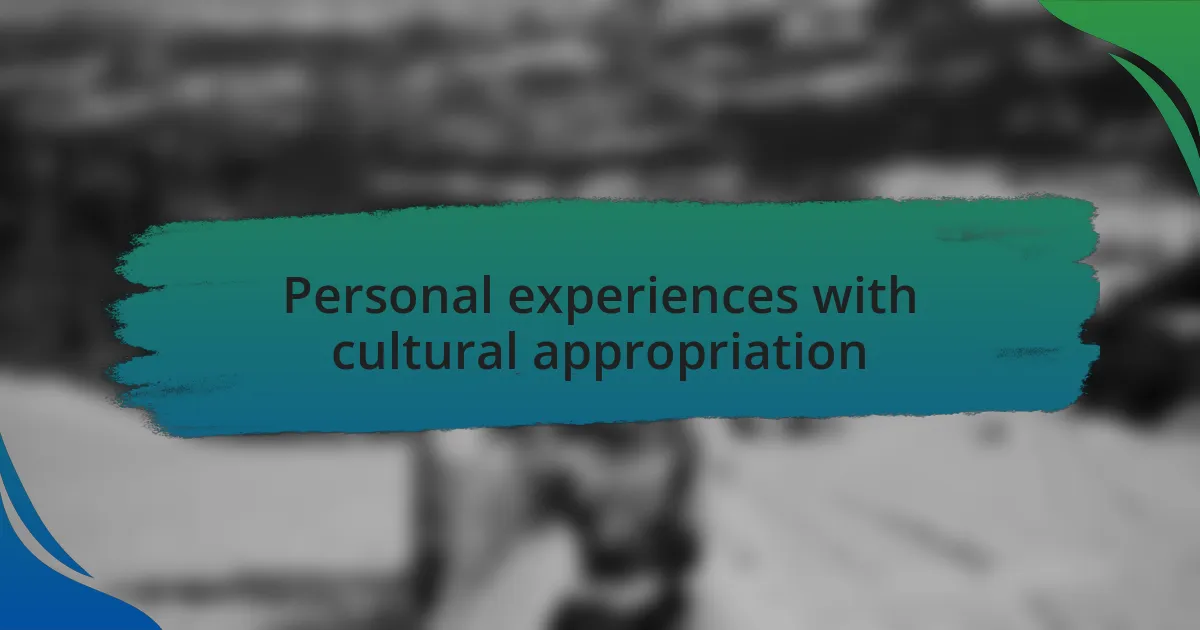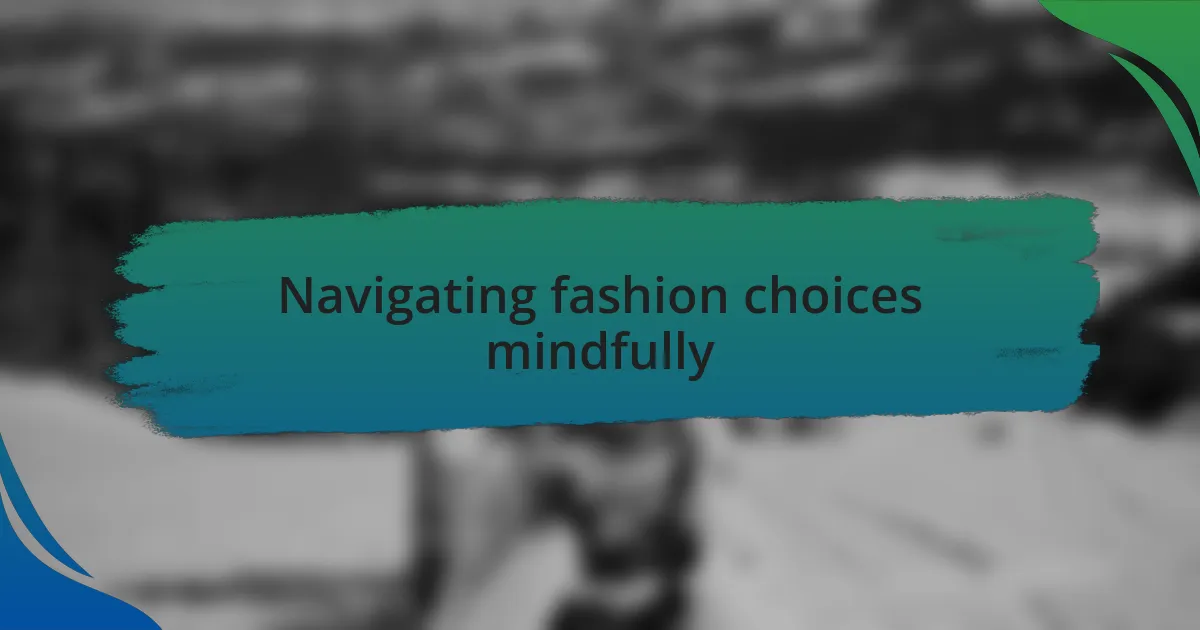Key takeaways:
- Cultural appropriation raises concerns about power dynamics and the commodification of marginalized cultures, emphasizing the need for empathy and understanding.
- Fashion choices should respect cultural significance, recognizing the narratives behind clothing rather than treating them as mere trends.
- Engaging directly with artisans and supporting inclusive practices can foster respect for cultural origins and enrich our wardrobes with authentic stories.
- Mindful fashion involves researching the origins of clothing and considering how to incorporate cultural elements without overshadowing their significance.

Understanding cultural appropriation
Cultural appropriation is a complex topic that often gets oversimplified. I remember a time when I saw a popular fashion brand launch a collection that heavily featured traditional elements from a culture they didn’t represent. It made me question, what happens when cultural symbols are stripped of their original meaning just to sell a product?
When I think about cultural appropriation, it sparks feelings of discomfort. It’s not just about borrowing styles; it’s also about power dynamics and respect. There’s something troubling about seeing marginalized cultures commodified while the deeper stories behind them remain unheard. How can we navigate this landscape without crossing boundaries?
I believe understanding cultural appropriation requires empathy and curiosity. It’s essential to think critically about whose voices are amplified and whose are quieted. Every piece of clothing carries a history, and being aware of that context can elevate our appreciation for diverse cultures instead of reducing them to mere trends.

Analyzing cultural elements in fashion
When we analyze cultural elements in fashion, I can’t help but reflect on the vibrant fabrics and intricate patterns that tell stories of heritage. I remember attending a local market where artisans displayed their handmade garments, each stitch woven with cultural significance. It made me realize that these elements shouldn’t just be seen as aesthetic choices in high fashion but should be celebrated and respected for their original context.
Consider the trend of wearing certain symbols or designs without understanding their meanings. I once saw a designer flaunt a collection inspired by Indigenous patterns, yet they seemed to bypass discussions around the communities those patterns originated from. How does that impact the people who have lived and breathed those traditions? It’s a striking example of how important it is to respect the narratives behind cultural elements, rather than merely using them as decoration.
I often think about the juxtaposition of influence and exploitation in fashion. It can be challenging to draw the line between appreciation and appropriation. The stories behind cultural garments are rich with struggles and triumphs, and when we fail to honor that, we risk trivializing entire cultures. Can we do better by engaging with and uplifting those stories rather than flattening them into trend-driven pieces?

Personal experiences with cultural appropriation
There was a time when I enthusiastically adopted a popular bohemian style, unknowingly blending elements from different cultures. I vividly recall a particular outfit adorned with a beautiful Indian textile, which I wore to a music festival. It wasn’t until a friend pointed out the significance of the fabric to her family’s heritage that I felt a pang of guilt, realizing I had missed an opportunity to honor its origin instead of merely flaunting it as a trendy accessory.
Another experience that stands out for me involved attending a fashion show that showcased a collection inspired by African prints. As I admired the stunning designs, a bitter taste lingered in my mouth. The models strutting down the runway wore those prints with an air of entitlement, yet the designers had not included voices from the actual communities whose culture those prints represented. This raised a troubling question: What would it take for designers to acknowledge their sources while celebrating the rich narratives woven into their collections?
During a conversation with a close friend from a Native American background, we delved into the appropriateness of wearing dreamcatcher jewelry. I had previously donned such pieces without questioning their significance. Listening to her perspective, I realized that many of us might wear these symbols without fully grasping the cultural weight they carry. This made me wonder how many others walk through life wearing borrowed pieces of identity, oblivious to the stories behind them.

Navigating fashion choices mindfully
When it comes to choosing what to wear, I often find myself pausing to reflect on the origins of my wardrobe pieces. One day, I picked up a colorful poncho at a thrift store and felt a surge of excitement. But then it hit me—is this vibrant piece merely a fashion statement for me, or does it carry a story from a culture that deserves to be respected? That moment shifted my shopping habits; now, I research the backgrounds of my clothing to ensure I’m honoring rather than appropriating.
I remember a conversation with a group of friends while discussing our go-to outfits for an upcoming event. One friend proudly showcased a kimono-inspired jacket she planned to wear but hadn’t looked into its cultural significance. As I listened, I felt compelled to share my thoughts: Why not explore wearing pieces that celebrate diversity while appreciating their authentic roots? It was enlightening for all of us, highlighting the idea that mindful fashion can enhance our understanding of different cultures rather than dilute them.
Practicing mindful fashion doesn’t just apply to what we wear; it’s about how we wear it. I once attended a cultural festival where each participant dressed in traditional attire, and I felt a wave of gratitude watching them embrace their heritage. Their confidence sparked a question in me: How can I incorporate elements of different cultures into my style without overshadowing their significance? I’ve begun to see fashion as a way to spark conversations rather than just a visual feast, reminding us all to engage thoughtfully with the fabric of our communities.

Promoting inclusive fashion practices
When I think about inclusive fashion practices, I often recall my visit to a local artisan market. I was captivated by a vendor showcasing intricate jewelry, each piece reflecting cultural stories. It was a moment of realization for me—why don’t we actively seek out these artisans, giving them a platform instead of simply borrowing their designs? Supporting these creators not only honors their craft but also enriches our wardrobes with authentic pieces that tell real stories.
I’ve also experienced the power of community workshops focused on fashion sustainability and inclusivity. During one session, I met a designer who incorporated fabrics from various cultures into her collections while ensuring she collaborated with the original artisans. It sparked a thought: could we advocate for brands to adopt similar practices? The dialogue that emerged was invaluable, highlighting how collaboration fosters respect and understanding rather than appropriation.
I recently participated in a swap clothing event, where individuals exchanged gently used garments instead of buying new ones. It was exciting to hear the stories behind each piece—like the hand-knitted sweater brought by someone whose grandmother made it. This experience helped me see that promoting inclusive fashion isn’t just about consumption; it’s about celebrating the narratives woven into our clothing. How can we transform our shopping habits into opportunities for honoring diverse cultures, creating a mindful wardrobe that’s as meaningful as it is stylish?